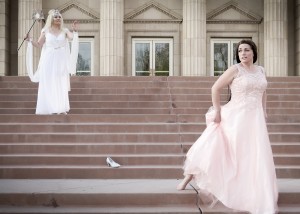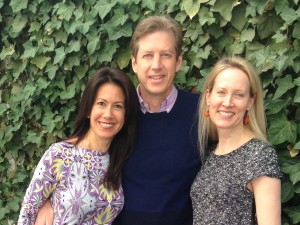Even though Jules Massenet’s opera Cendrillon (Cinderella) is hardly known in Utah, the fairy tale on which it’s based certainly is universally known, thanks to the magic of Disney.
So when the University of Utah’s Lyric Opera Ensemble decided to do the Massenet opera this spring — a first for Utah, by the way — stage director Michael Scarola knew he wanted to do something a bit different with it. “I wanted to do come up with something unique,” he said in an interview with Reichel Recommends.
After tossing a lot of ideas around, steampunk came up. “I didn’t know much about it so I did some research,” Scarola said. “I found out there are all kinds of steampunk, including sci-fi, Western and Victorian.”

From left: Ruth Ellis as the Fairy Godmother, Jennifer Erickson as Cendrillon. (Photo Credit: Emily Nelson)
When he discovered Victorian steampunk, Scarola was hooked. “I knew exactly what I wanted to do.” He admitted that he likes everything Victorian. “The Victorian period is a favorite of mine. I’m attracted to it — to its society, clothing, everything.”
And the Victorian era fits in with the Cinderella story quite nicely, as well. “Back then you had royalty, elitists, servants. It’s the story of Cinderella, because all the elements are represented. And it fits in with the steampunk imagery, and that imagery fits in with the text. It lets me stay true to the text and music.”
Robert Breault, who heads the opera program at the U., is looking forward to having the Lyric Opera Ensemble be the first to bring Massenet’s 1899 opera to Utah. Speaking by phone from Edmonton, Canada, where he was rehearsing Lucia di Lammermoor, Breault said, “Why doesn’t [Cendrillon] get done? I don’t know. It has an immediate appeal and it’s got something for everyone. Kids and adults will each enjoy different elements of it.”
Cendrillon does get revived every so often and there are several good recordings available. “I saw it at [New York] City Opera several years ago,” Scarola said. Mezzo-soprano Joyce DiDonato has played a major role in bringing the work to opera houses here and in Europe. “She has been the one who has done more than anyone else to revive it. She’s done it at the Royal Opera and at Barcelona, and also recorded it. And the way she sings [the title role] is amazing.”
Unlike Rossini’s version of the story, in which there are no fairytale elements, Massenet’s embraces all of the magic. “You have to believe in spirits and in a fairy godmother,” Breault said. “It’s pure escapism.”
This production will also include dancers from the U.’s ballet program. “This is the first time we’ve collaborated with another department and we’re excited it’s happening,” Breault said.
The U.’s dance department recently presented its own steampunk version of Prokofiev’s ballet Cinderella, and with some alterations the pas de deux from the ballet will be danced in the opera’s second act. It required some reworking of the opening scene of Act II, but without compromising the integrity and intention of the libretto. “I don’t want to give too much away, but the way we ended up incorporating the ballet into the opera will have the two worlds — Prokofiev’s Cinderella and Massenet’s Cendrillon — come together,” Scarola said.
“I think what we’ve done with it will have people say, ‘Gee, I’m glad I saw it,’” Breault said.
The opera is double cast. Singing the leads are Gretchen Windt and Jennifer Erickson (Cendrillon); Ruth Ellis and Emily Nelson (The Fairy Godmother); and Sidnei Alferes and David Sauer (The Prince).
Also in the cast are Hayley Bell and Makenzie Matthews (Madame de la Haltière); Jared Lesa and Daniel Tuutau (Pandolfe); Hillary Koolhoven and Michelle Dean (Noémie); Alyssa Marie Jenks and Stania Shaw (Dorothée); Scott Hebertson and Nathan Curtis (The King); Gregory Harrison and Hunter Olsen (The Dean of the Faculty); Anders Larson (The Master of Ceremonies); and Garrett Tyler Madlock (The First Minister).
Robert Baldwin will conduct the Utah Philharmonia.
- PERFORMANCE DETAILS
- What: Utah Lyric Opera Ensemble, Jules Massenet’s Cendrillon
- Venue: Kingsbury Hall
- Time and Date: 7:30 p.m. April 24-25
- Tickets: $20 general, $10 non U. students, free for U. students and children 17 and under
- Phone: 801-581-7100
- Web: www.kingtix.com

